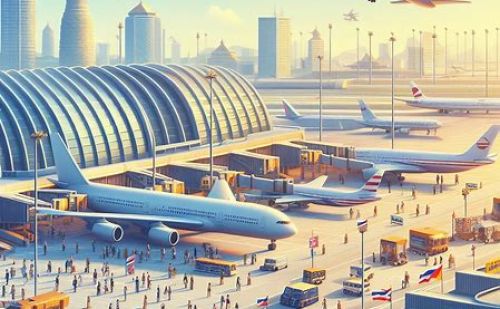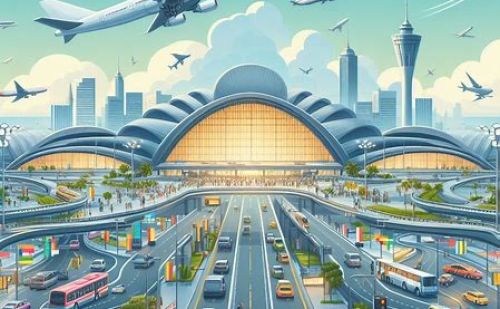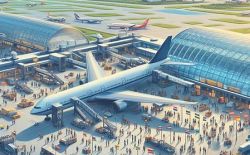Suvarnabhumi Airport Bangkok
Introduction
If you are traveling to Bangkok, the capital and largest city of Thailand, chances are you will be landing at Suvarnabhumi BKK Airport, the main international airport serving the city and the country. Suvarnabhumi BKK Airport is one of the busiest and most modern airports in Southeast Asia, and a regional hub for aviation and tourism. Suvarnabhumi BKK Airport offers a range of facilities, services, and amenities to make your arrival, departure, or transit smooth and comfortable. Suvarnabhumi BKK Airport is more than just an airport, it is a gateway to Bangkok and beyond.
The main idea and purpose of this article is to provide you with an informative and comprehensive overview of Suvarnabhumi BKK Airport, its history, facilities, services, and tips. By the end of this article, you will have a better understanding and appreciation of Suvarnabhumi BKK Airport, and hopefully, you will have a pleasant and enjoyable experience at the airport. Suvarnabhumi BKK Airport is the ultimate airport for Bangkok, and you should not miss it.
History of Suvarnabhumi BKK Airport
Suvarnabhumi BKK Airport has a long and interesting history, dating back to the 1960s, when the Thai government decided to build a new airport to replace the overcrowded Don Mueang Airport, which was then the only international airport in Bangkok. The new airport was planned to be located in the eastern outskirts of Bangkok, in an area called Nong Ngu Hao, which means "Cobra Swamp" in Thai. The construction of the new airport began in 1973, but was delayed and suspended several times due to political and economic problems, as well as environmental and technical issues. The new airport was finally completed and opened in 2006, after more than three decades of planning and building. The new airport was named Suvarnabhumi, which means "Land of Gold" in Sanskrit, a name chosen by the late King Bhumibol Adulyadej, who also presided over the official opening ceremony of the airport. Suvarnabhumi BKK Airport was designed to be a state-of-the-art and world-class airport, with a capacity of 45 million passengers and 3 million tons of cargo per year. Suvarnabhumi BKK Airport is currently undergoing expansion and development projects, to increase its capacity and efficiency, and to accommodate the growing demand and expectations of travelers and airlines.
Facilities of Suvarnabhumi BKK Airport
Suvarnabhumi BKK Airport offers a range of facilities to cater to the needs and wants of travelers and airlines. Some of the main facilities of Suvarnabhumi BKK Airport are:
Terminal
Suvarnabhumi BKK Airport has one main terminal building, which is divided into four concourses: A, B, C, and D. The terminal building has seven floors, with the first floor being the arrivals hall, the second floor being the bus and taxi lobby, the third floor being the meeting point and public transportation center, the fourth floor being the departures hall, the fifth floor being the airline offices, the sixth floor being the observation deck, and the seventh floor being the airport hotel. The terminal building has a total area of 563,000 square meters, making it one of the largest airport terminals in the world. The terminal building has a distinctive design, featuring a curved roof that resembles a wave, and a glass wall that allows natural light to enter. The terminal building also has a number of facilities and services, such as check-in counters, immigration and customs, baggage claim, security screening, information desks, currency exchange, ATMs, lounges, restaurants, shops, duty-free, Wi-Fi, medical center, prayer room, smoking room, spa, and more.
Runways
Suvarnabhumi BKK Airport has two parallel runways, which are 01L/19R and 01R/19L. The runways are 3,700 meters and 4,000 meters long, respectively, and are made of asphalt concrete. The runways are equipped with advanced lighting and navigation systems, such as the Instrument Landing System (ILS), the Precision Approach Path Indicator (PAPI), and the Distance Measuring Equipment (DME). The runways can handle all types of aircraft, including the Airbus A380, the world's largest passenger aircraft. The runways can also operate simultaneously, allowing for a maximum of 76 flights per hour. Suvarnabhumi BKK Airport is currently constructing a third runway, which will be 02L/20R, and will be 4,000 meters long. The third runway is expected to be completed and operational by 2023, and will increase the capacity and efficiency of the airport.
Apron
Suvarnabhumi BKK Airport has a large apron area, which is the area where aircraft are parked, loaded, unloaded, refueled, and serviced. The apron area has a total of 120 parking stands, which are divided into 51 contact stands and 69 remote stands. The contact stands are connected to the terminal building by aerobridges, which allow passengers to board and disembark the aircraft without having to walk on the ground. The remote stands are located away from the terminal building, and require passengers to use buses to travel between the aircraft and the terminal. The apron area also has a number of facilities and services, such as fueling stations, ground power units, air conditioning units, water and waste services, catering services, and more.
Tower
Suvarnabhumi BKK Airport has a control tower, which is the structure that provides air traffic control and communication services to the aircraft and the airport. The control tower is located near the terminal building, and has a height of 132.2 meters, making it one of the tallest airport control towers in the world. The control tower has a circular shape, with a diameter of 42 meters, and has a glass facade that offers a 360-degree view of the airport and the surrounding area. The control tower has a number of facilities and equipment, such as radar, radio, telephone, computer, and meteorological systems, that enable the controllers to monitor and direct the movements of the aircraft and the vehicles on the ground.
Other Facilities
Suvarnabhumi BKK Airport has a number of other facilities that support the operation and management of the airport. Some of these facilities are:
- The Airport Rail Link, which is a train service that connects the airport to the city center and other destinations in Bangkok. The Airport Rail Link has two lines: the Express Line, which runs non-stop between the airport and Makkasan Station, and the City Line, which stops at six stations between the airport and Phaya Thai Station. The Airport Rail Link operates from 06:00 to 24:00, and takes about 15 to 30 minutes to travel between the airport and the city.
- The Public Transportation Center, which is a facility that provides bus and taxi services to and from the airport. The Public Transportation Center is located on the third floor of the terminal building, and has a number of counters and booths that offer various options and information for travelers. The Public Transportation Center also has a shuttle bus service that runs between the terminal and the bus and taxi lobby on the second floor.
- The Airport Free Zone, which is a designated area that offers tax and duty exemptions and incentives for businesses and investors who operate within the airport. The Airport Free Zone covers an area of 600 hectares, and has a number of facilities and services, such as warehouses, offices, factories, customs, banking, and more. The Airport Free Zone aims to promote and facilitate trade, logistics, and aviation-related activities at the airport.
- The Novotel Suvarnabhumi Airport Hotel, which is a four-star hotel that offers accommodation and amenities for travelers and visitors who need to stay near the airport. The Novotel Suvarnabhumi Airport Hotel is located on the seventh floor of the terminal building, and has 612 rooms and suites, as well as a number of facilities and services, such as restaurants, bars, swimming pool, fitness center, spa, meeting rooms, and more. The Novotel Suvarnabhumi Airport Hotel also has a 24-hour check-in and check-out service, and a free shuttle bus service that runs between the hotel and the terminal.








